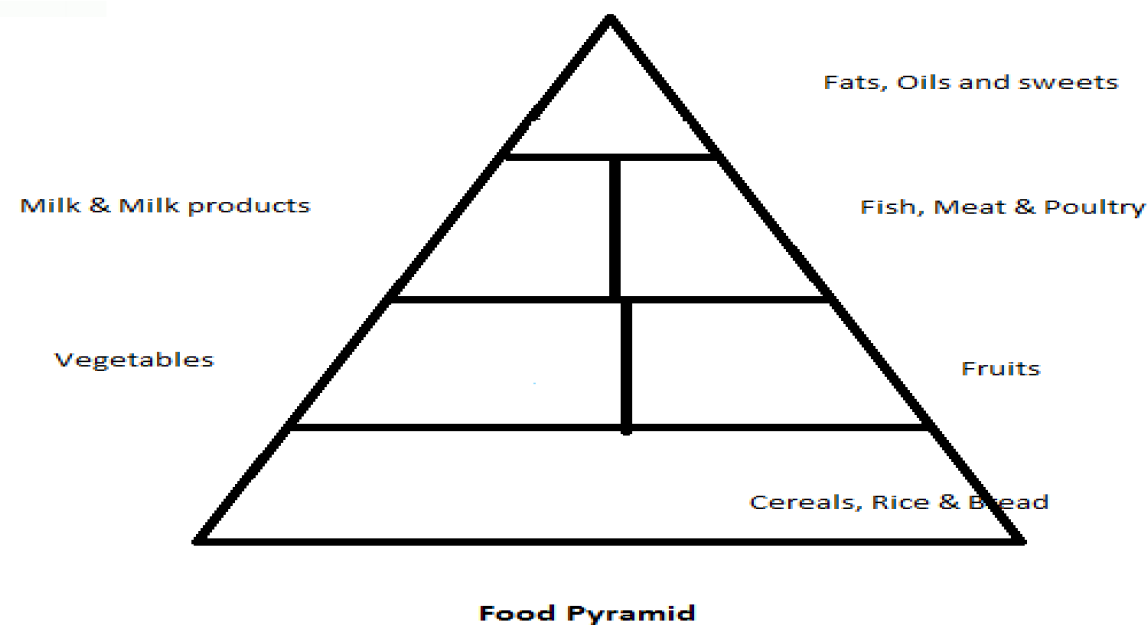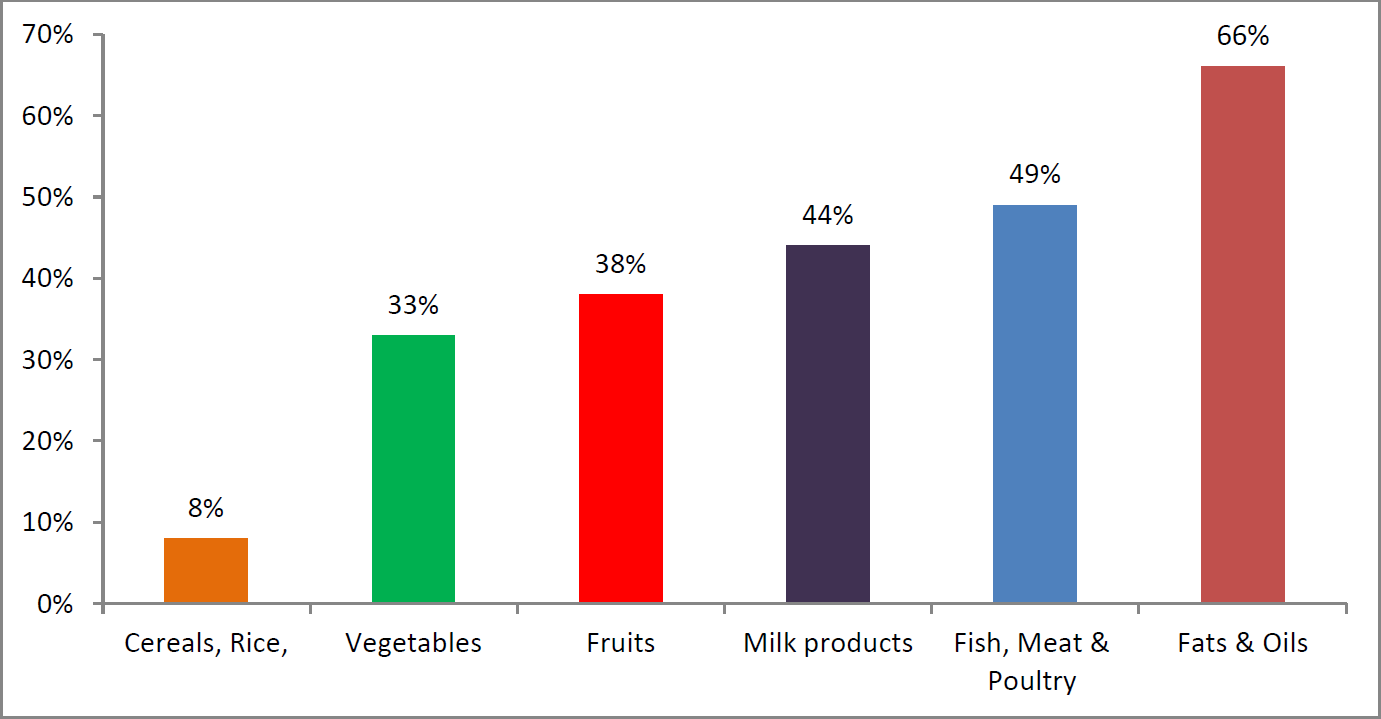Translate this page into:
Knowledge of food groups among mothers of preschool Children in a rural area of Villupuram district, Tamilnadu.
Corresponding author: Dr. Abel K Samuel Johnson, Assistant Professor, Community Medicine, Believers Church Medical College, Thiruvalla, Kerala. Email : abelksj@gmail.com
Abstract
Introduction:
Nutrition is defined as the process by which the organism utilizes food. Malnutrition is a major public health problem as both under nutrition and obesity has serious negative health implications. Childhood malnutrition adversely impacts the overall lifelong health of individuals by affecting growth and development.
Materials and Methods:
A cross sectional study was conducted among the mothers of under five children in Anaichikuppam, a rural area of Villupuram district during the month of November 2013. A total of 157 mothers of pre school children were interviewed in the study. The mothers were asked to fill six food groups in the appropriate boxes based on the requirements per day in the “The food guide pyramid”. The food items present in the food pyramid were given in the questionnaire and asked to mark in the appropriate boxes based on their priority.
Results:
A total of 157 mothers were interviewed in the study. Maximum number of mothers marked fats and oils (66%) against the appropriate box in the food pyramid. Majority of the mothers (92%) had wrong perception about cereals and marked it wrongly in the food pyramid.
Conclusion:
The knowledge of the mothers regarding nutrition is fairly acceptable in our study population. More emphasis needs to be given to fruits, vegetables and cereals since least priority has been given to these food groups.
Keywords
Food pyramid
nutrition
preschool
rural.
Introduction:
Nutrition is defined as the process by which the organism utilizes food.[1] Malnutrition is a major public health problem as both under nutrition and obesity has serious negative health implications. Childhood malnutrition adversely impacts the overall lifelong health of individuals by affecting growth and development.[2] Today the World faces a double burden of malnutrition that includes both under nutrition and overweight, especially in developing countries. Globally, about 104 million children are underweight and about 43 million children are overweight[3]and are directly correlated with heart disease, diabetes, stroke, liver disease, and cancer, among others.[4]
India has more number of underweight children than the whole of impoverished Sub-Saharan African countries. One in three of world's malnourished children lives in India.[3] Forty three percent of Under-five children in India are underweight.[5] A study by Stalin P et al. in Kancheepuram district of Tamil Nadu found that the prevalence of underweight among under-five children was 52.9%. Around 7% of children were severely malnourished.(6)
Basic four food groups (Meat & milk, fruits, Vegetables, cereals) was developed by the U.S state department of agriculture based on the common foods that the Americans consume. The China health study identified four food groups (Green leafy vegetables, Soya bean products, Sweet Potatoes and cereals) that the Chinese follow (12). Each of these food groups provide some, but not all, of the nutrition required. A diet based on more of vegetables and less of meat & meat products similar to the Chinese diet would improve health(13)
WHO, as early as 1963 identified that malnutrition is largely a by-product of poverty, ignorance, insufficient education, lack of knowledge regarding the nutritive value of foods, inadequate sanitary environment and large family size. Maternal factors had significant influence on the nutritional status of the child.[7] Proper nutrition is integral for disease prevention as well as treatment, but there exists a shortage on the maternal knowledge about nutrition and malnourishment.[8]Several studies indicate the association of maternal nutritional knowledge and malnourishment .[9-11]Thus this study was planned to assess the knowledge of nutrition among the mothers of the preschool children.
Materials and Methods:
A cross sectional study was conducted among the mothers of under five children in Anaichikuppam a rural area of Villupuram district which is also the field practice area of the Department of Community Medicine, PIMS, during the month of November 2013.A total of 157 mothers were interviewed in the study. The mothers were asked to fill six food groups in the appropriate boxes based on the requirements per day in the “The food guide pyramid”.(14)The food items present in the food pyramid like fruits, fat and oil, fish, meat and poultry, bread, milk and vegetables were given in the questionnaire and asked to mark in the appropriate boxes in food pyramid according to their priority.
A nutritional education guide “The food guide pyramid” (Figure 1) which emphasizes on the prioritization of the most needed food group to assess the knowledge on nutrition among mothers of preschool children was used to explore the maternal knowledge about the food and dietary requirements of the child.

- Food Pyramid
Results:
A total of 157 mothers were interviewed in the study. Maximum number of mothers prioritised fats and oils (66%) against the appropriate box in the food pyramid. About fifty percent of the mothers found the appropriate place for meat, poultry and fish in the food pyramid (49%) followed by milk and milk products (44%).
Majority of the mothers (92%) had wrong perception about cereals and marked it wrongly in the food pyramid. Only thirty three percent of the mothers marked vegetables in the appropriate box and 38% marked fruits in the appropriate box. (Figure. 2)

- Proportion of mothers who filled the pyramid correctly
Discussion:
Suboptimal diet is the single leading modifiable cause of poor health in the World. Consumption of at least 400 grams per day of fruit and vegetables is recommended to reduce the risk of chronic diseases.(14) Observational studies have shown that diets high in fruits and vegetables are associated with lower risk of heart disease and cancer. Nationally representative surveys, however, indicate that throughout most regions of the globe, daily consumption of fruits and vegetables is well below such recommendations.(15) South East Asian nations report the lowest quantities of child fruit and vegetable intake.(15) Our study was conducted in a community where fishing is the main occupation. The lack of home grown or locally produced vegetables and fruits may be another reason for low prioritization of fruits and vegetables.
The perception of the mothers about the intake of fats and oils in the diet of their children was better. This may be due to the increased awareness activities regarding the negative role of fats and oils in causing non communicable diseases and cardiovascular diseases. A systematic analysis done in 266 countries also found that optimal intake of fat were higher among younger age groups. [16]
Most of the families in our study area belong to the fishermen community. Fish was their staple food and was available in plenty. This has led to the correct perception of more number of mothers regarding the importance of fish, meat and poultry in the diet of their children and this might be the reason for least prioritisation of cereals by the mothers.
Milk was regarded as a food of choice by 44% of the mothers as milk was considered a kids meal due to wide spread advertisements and local beliefs. However as the study participants was not from an agrarian society, milk was also not marked in the appropriate box in the pyramid.
Conclusion:
The knowledge of the mothers regarding nutrition was fairly acceptable in our study population. More emphasis needs to be given to fruits, vegetables and cereals since least priority has been given to these food groups.
Food in one group can't replace those in another. No one of these major food groups is more important than another- for good health one needs them all
References:
- Dietary tips for better health. Ministry of Women and Child development, Govt of India 2007
- [Google Scholar]
- Nutrition. UNICEF India. [Internet]. Available from: http://www.unicef.org/India/childr en_2356.htm (accessed )
- [Google Scholar]
- Double burden of Malnutrition in low and middle income countries. Journal of Global health. 2012;2(2):020303.
- [CrossRef] [Google Scholar]
- NFHS-3. [Internet]. Available from: http://motherchildnutrition.org/Ind ia/pdf/nfhs3/mcn-nfhs-3 -nutrition- and-anaemia.pdf (accessed )
- [Google Scholar]
- Prevalence of Underweight and its Risk Factors among Under Five Children in a Rural Area Of Kancheepuram District in Tamil Nadu, India. IOSR Journal of Dental And Medical Sciences (IOSR-JDMS). 2013;3(6):71-74.
- [CrossRef] [Google Scholar]
- Nutritional status of Under-five children on National Immunisation Day in Srinagar. Available from: http://www.jkscience.org/.../nuriti onal%20status%20of%20uner%20 5%20srinagar.pdf (accessed )
- [Google Scholar]
- A case-control study of maternal knowledge of malnutrition and health-care-seeking attitudes in rural South India. Yale Journal of Biology and Medicine. 1997;70(2):149-60.
- [Google Scholar]
- Reasoning about childhood nutritional deficiencies by mothers in rural India: A cognitive analysis. Soc. Sci. Med. 1993;37:937-962.
- [CrossRef] [PubMed] [Google Scholar]
- Relation of childhood malnutrition to parental education and mothers' nutrition related KAP. Indian journal of Pediatrics. 1991;58(2):269-74.
- [CrossRef] [PubMed] [Google Scholar]
- Parental education and child health: intracountry evidence. Indian J Pediatr. 1992;2(3-4):14-15.
- [Google Scholar]
- The food guide pyramid. United States Department of Agriculture. Report number. 1992;2
- [Google Scholar]
- The global burden of disease attributable to low consumption of fruit and vegetables: implications for the global strategy on diet. Bulletin of the World Health Organization. 2005;83:100-8.
- [Google Scholar]
- “Global, Regional, and National Consumption Levels of Dietary Fats and Oils in 1990 and 2010: a Systematic Analysis Including 266 Country-Specific Nutrition Surveys.”. BMJ : British Medical Journal. ;348(2014):g2272.
- [CrossRef] [PubMed] [Google Scholar]






